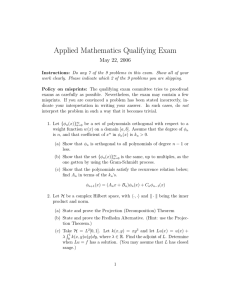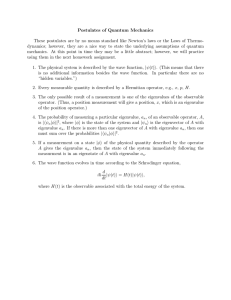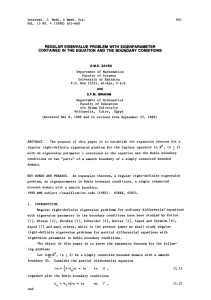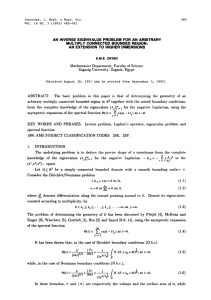EIGENFUNCTION A FOURTH WITH EIGENVALUE PARAMETER
advertisement
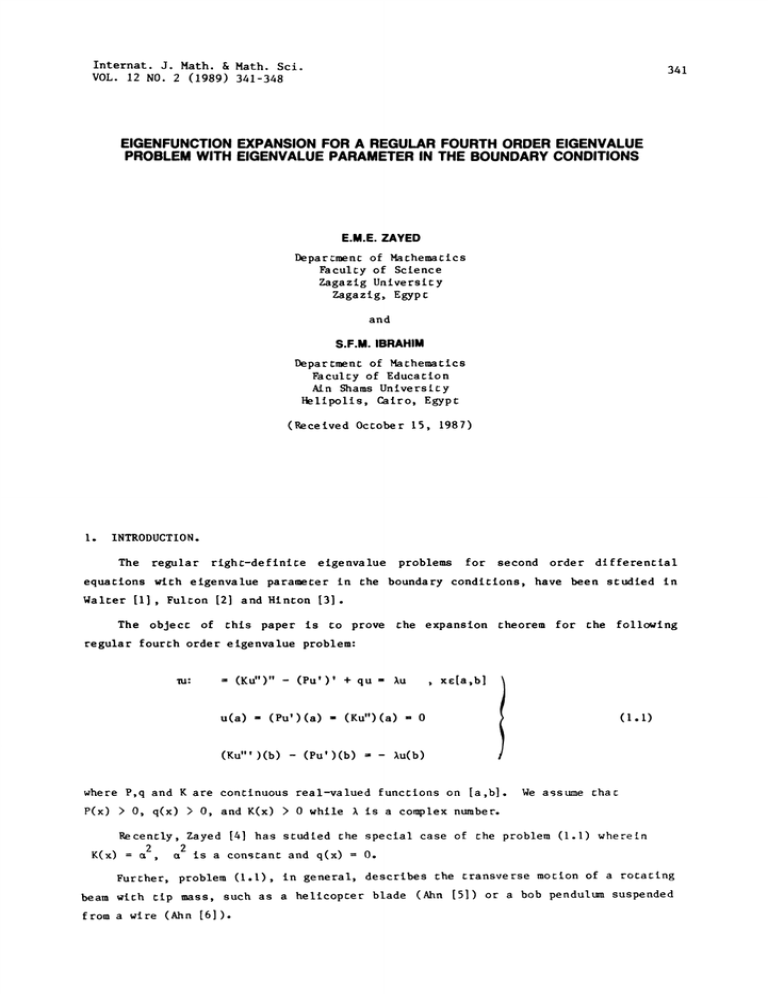
Internat. J. Math. & Math. Sci.
VOL. 12 NO. 2 (1989) 341-348
341
EIGENFUNCTION EXPANSION FOR A REGULAR FOURTH ORDER EIGENVALUE
PROBLEM WITH EIGENVALUE PARAMETER IN THE BOUNDARY CONDITIONS
E.M.E. ZAYED
Department of Mathematics
Faculty of Science
Zagazlg University
Zagazlg, Egyp
and
S.F.M. IBRAHIM
Department of Mathematics
Faculty of Education
/kin Shams Unlversicy
Hellpolls, Cairo, Egypt
(Received October 15, 1987)
INTRODUCTION
problems
regular rlght-deflnlte elgenvalue
The
for
second order differential
equations with elgenvalue parameter in the boundary conditions, have been studied in
Walter
[I], Fulton [2] and Hlnton [3].
The object of this paper is o prove the expansion theorem for the following
regular fourth order elgenvalue problem:
(Pu’)’ + qu
(Ku")"
u:
u(a)
(Pu’) (a)
(Ku"’)(b)
(Ku") (a)
(Pu’)(b)
x[a,b]
Au
0
),u(b)
where P,q and K are continuous real-valued functions on [a,b].
P(x)
K(x)
>
0, q(x)
>
0, and K(x)
>
We assume that
0 while I is a complex number.
Recently, Zayed [4] has studled the special case of the problem (I.I) wherein
2
2
0.
is a constan and q(x)
=
=
Further, problem (I.I), in general, describes the transverse motion of a rotating
beam with tip mass, such as a helicopter blade (Ahn [5]) or a bob pendulum suspended
from a wire (Ahn
[6]).
342
E.M.E. ZAYED AND S.F.M. IBRAHIM
Ahn [7] has shown that the set of elgenvalues of problem (l.l) is not empty, has
no finite accumulation points and is bounded from below.
He used an Integral-equation
a pproach.
In thls paper, our approach ts to glve a Hi lbert space formulation to the problem
(I.I) and self-adJolnt operator defined In it such that (I.I) can be considered as the
efgenvalue problem of thls operator.
2.
HILBERT SPACE FORMULATION.
We define a Hilbert space H of two-component vectors by
L2(a,b) ( C;
H
with Inner product
b
flldx + f2g-"2
<f,g>
a
and norm
b
2
,f,g
2
(2.)
2
(2.2)
whe re
f
(fl’ f2
(fl (x), fl(b))
g
(gl’
(gl (x),
H
and
g2
gl (b)
We can define a linear operator A:D(A)
(Tfl,- (Kf")(b)
Af
where
the
D(A)
domain
of
A is
a
g
H
H by
(Pf;)(b)) V
+
set
of
all f
f
(fl,f2)
(fl’f2)
D(A)
H which
(2.3)
satisfy
the
following:
fl’
f
and
fl
are absolutely conClnuous with
b
"r1L2(a,b) and (Klfj 2
/
a
fl(a)
(ill)
(Pfi)(a)
(Kf)(a)
Pjflj 2 + qjfll2)dx <
..
0
f2 fl(b)
REMARK 2.1.
The parameter
Is an elgenvalue of (1.1) and f
is a corresponding
eigenfunctlon of (I.I) If and only if
f
(fl,fl(b))
D(A)
and
Af
Af
Therefore, the eigenvalues and the elgenfunctions of problem (I.I) are equivalent
to the elgenvalues and the etgenfunctions of operator A.
EIGENFUNCTION EXPANSION FOR A FOURTH ORDER EIGENVALUE PROBLEM
343
We consider the followlng assumptions:
(1)
x/li
[K’(x)f l(x)
K(x)f|’(x)]
O,
(ll)
x+ll
[K’ (x)g i(x)
K(x)gi’ (x)
0
LEMMA 2.1.
PROOF.
The linear operator A in H is symmetric.
On using the boundary conditions of (I.I) we get,
b
f
<Af,g>
T
)idx + [-(Kf{")
f
a
(b) +
b
b
(Pf)(b)]I (b)
b
f (Kf;’)"idx- af (Pf)’idx + af qf1dx- (Kf")(b)l (b)
a
+
(Pf) (b)g l(b)
(2.6)
Integrating the first term of (2.6) by parts four clmes and Integraclng the second
(2.6) by parts twice, we gec
term of
b
(P-)’
f f [(’)’’
<’g>
+
+
q-l ]dx + fl(b) t-(K-")(b)+(’)(b)l
K(b)g(b)]
f’(b) [K’(b)gl(b)
gl(b) [K’(b)fl(b)-K(b)f(b)]
Applying the conditions (2.5) and uslng the boundary conditions of
(l.l))we
obtain
b
<Af
f fl(--gl )dx
g>
+
a
REMARK. 2.2.
(fl ’f2
For all f
fl (b) [--gl’")(b)
in D(A) and
+
<f Ag>.
(Pg)(b)]
f2 fl (b)
#:
0, the domain D(A) is
dense in H.
Since the operator A in H is symmetric and dense In
3.
H, A is self-adJolnt.
THE BOUNDEDNESS.
We
shall
show
bounded from below.
that
the
self-adjolnt operator A is unbounded
from above
and
We also show that A is strlctly positive.
LEMMA 3.1.
(i)
If
f,f’
are
[a,b], then
conclnuous
absolutely
P(x)
we have
)
c
with
f(a)
for some constant c
0
>
and
P(x)
0 such that
b
a
(ll) For
fC2[a,b],
there exlscs a positive constant c 2 such chac
b
b
2
fa If(x)l
dx, c
2
f
a
>
0
in
E.M.E. ZAYED AND S.F.M. IBRAHIM
344
PROOF.
(i)
Since
>
P(x)
0 tn [a,b], we have P(x)
for some c
)c
>0.
Consequently, on using Schwarcz’s inequality, we get
b
I
a
b
<I’<I 2
b
I’<I
I
a
f
a
I’<I
b
O.
Since f(a)
f(b)
f(a)
f(b)
’(x)dx
where
a
(if) By using Theorem 2 in [8, p.67], we have for f(x)
f If(x)
a
Since
the n
2
’ 4(b-a)
dx
’41
dx
dx’ 4(b-a)
I ldl()l
2
a
If’(x) t,
Applying (3.1) again for
b
f If’(x)
a
2
dx
dx
a
12dx
dx-
b
f I<)l
a
d
f(._.
2
ecl[a,b],
b
2
dx
dx < 16(b-a
)2 f
a
If’ (x) j2dx
(3.1)
we get
, 16(b-a) 2 bf
f"(x)
2dx
(3.2)
a
from (3.1) and (3.2) we get
b
b
f If(x)l 2
a
2
fa If"(x)l 2
dx where the constant
c2=256(b-a) 4.
The linear operator A is bounded from below.
LEMMA 3.2.
PROOF.
dx’ c
On using the boundary conditions of (I.I) we get
b
f
a
(T
fl)ldx +
[-(Kf")(b) +
b
b
b
(Pfl)(b)]-l(b)
f (Kf’)"l dx- af (Pf’l)-’fl dx + af qfl’l dx-(Kf{") (b)[l (b)
a
+
(Pf)(b)T l(b).
(3.3)
In=egractng (3.3) by parts twice and using she boundary conditions of (1.1), we obtain
b
<Af f>
f;(b) tK’(b)l(b)
b
b
a
a
K(b)l(b)] + af Klfli2d
X
On using (2.5) (ll) and lemma (3.1), we gec
<Af,f>
dx
EIGENFUNCTION EXPANSION FOR A FOURTH ORDER EIGENVALUE PROBLEM
345
b
a
where
c
follows,
Since" c
>
from
O, K(x)
positive (c
>
+ q(x)
xs[a,b]
where he constan c
It
[K(x)
inf
3
Therefore
>
cl).
rain (c 3,
(3.4),
0, q(x)
thac
>
the
>
O, c
A
operator
2
O) and hence A Is strictly positive.
I)
from
bounded
is
mln (c 3,c
0 and c
the
then
below.
c
constant
is
REMARK 3. I.
(i)
Since A is a symmetric operator (from lemma 2.1) then A has only real
e ige nva lue s.
(ll) By Lemma 3.2, we deduce chat the set of all elgenvalues of A is also
bounded from below.
(ill)Since A is strictly poslclve, then the zero is not an elgenvalue of A.
By using theorem 3 in [8, p.60] we can state that:
Since A in H is smmetrlc and bounded from below, then for every elgenvalue
p c where the constant c is the same as in (3.4).
A in H,
This means that
0
<
c
%1
%1
%2
%i
according to the slze and
as I
%1
%1
of
(R).
This implies that the set of all elgenvalues of A Is unbounded from above.
REMARK
3.2.
the
Since
A
operator
self-adJolnc, chert A has only real
By using theorem 3 in [8,
is
elgenvalues and the elgenfuncclons of A are orthonormal.
p.30],
the
density
of
the
4.
D(A)
in
H gives
QI’Q2’Q3’
of A.
domain
orthonormal system of elgenfunctlons
us
the
completeness
of
the
THE EIGENFUNCTIONS OF THE OPERATOR A.
We suppose
%(x), %(x), X%(x)
and
y%(x),
where %
6
C is noc an elgenvalue of A,
are the fundamental set of solutions of the fourth order differenclal equation of
(I.I) with the initial conditions:
(4oi)
,(a)
O,
(P’)(a)
0,
’(a)
l,
(K,%)(a)
x%{’a).
O,
-(P")(a)
0,
-A-’"(a)
0,
(Kb’")(a)..k
(4.2)
x%(b)
0,
(Px’,)(b)
l,
x%(b)
O,
(Kx")(b)
(4.3)
y%(b)
I,
(Py’)(b)
I+%,
’(b)
O,
(Ky’’)(b)
(4.4)
-k-
Therefore the Wronsklan is
w
--tim
x/b
x,(x) (t:’.)(.)
(t:’x)(x)..)
-x
,o
0
346
E.M.E. ZAYED AND S.F.M. IBRAHIM
Thus the solutions
Putting x
Ck(x),@k(x),xk(x)
and
yk(x)
are linearly independent of
Tu
ku.
b, we obtain the Wronsklan in the form:
W
Now,
OA(b) [XCA(b)
(P)(b)
+
0xCb) [XA(b)
(P,’Q(b)
+ (K*’")Cb)]
(fl’f2)
for f
of (xi- A)
H, we
(KCA’")(b)
(01,02)
define 0
#
(4.5)
0
D(A) as
the
unique
solution
f.
Application of variation of parameter method yields the unique solution
D(A) of (AI
A)@
T)
XI
H with:
f, f
01
f
(4.6)
A01Cb)
(P01)Cb)
+
(K01")Cb)
f2
The re f o re
f
a
+
fl (t)dt
w
b
+
+
0ACx) al (t)
b
@1 (x)
xxCx)3(t)
+
fl (t)dt
W
dlCx(x)
+
d20x(x)
+
d3xx(x)
+
d4x(x),
(4.7)
whe r e
-p(c)
1 (t)
K(t)
2 (t)
,x(t)
,’x(t)
xx(c)
xx(c)
l(t:)
-P(C)
ct3(t)-’- t-----K(
and
P(t)
K(C)
t4(t)
while d
I,
d2,
d
3
and d
4
are constants
Of(b) O(b)
Calculation of
and ’"(b) from (4 7) and substitution into (4 6) with
-1
the initial conditions (4.3) and (4.4), we can get the constants dl, d2, d and d as
4
3
follows:
EIGENFUNCTION EXPANSION FOR A FOURTH ORDER EIGENVALUE PROBLEM
347
b
+
f2’(b)
[-
d
l(t)f l(t)d],
o
a
b
+
d2 --g if2 ,x(b
O.
d
and d
-
f
a
4
3
Consequently, we deduce thac
and
0
2
b
f2
01(x)
h(x)@’(b)]
[@A(x)(b)
+
f G(x,c,h)fl(t)dc
(4.8)
a
01 (b)
where G(x,c,h) is the Green’s function defined by:
(4.9)
G(x,t,h)
+
XhCX)a3(t
"Yh(X)a4(t)
<
a
t::
b
x
The form of equaclons (4.8) and (4.9) shows that the inverse operator (hi
is actually compact; for details of argument of theorem 5 in
5.
x
A)
-I
[8, p.120] can be used.
EXPANSION THEOREM.
H for
We now arrive ac the problem of expanding an arbitrary function f(x)
our
ivestlgatlons
of
results
The
(I.I).
[a,b] in terms of the elgenfunctlons of
are summarized in the following theorem:
THEOREM 5.1.
multlpllclty,
in
The operator A in H has unbounded set of real elgenvalues of finite
(they have at most multiplicity four),
(-, ) and they can be ordered according
with X
.
as I
I
If
to the size, 0
corresponding
the
X
<
f, 0
i
>
0
<
E
points
< hi
c 4
01 ,02 ,03
elgenfunctlons
complete orthonormal system, then for any function f(x)
f(x)
accumulation
wlthouc
form
H, we have the expansion:
(4.10)
i
which is a uniformly convergent series.
The above theorem has some interesting corollaries for particular choices of f.
COROLLARY 4.1.
If
fl eL2(a’b)
and f
b
(1)
fl= i--1
(ll)
o
(f flOildX)Otl(X)
a
b
7. (f flOtldX)Ot2
t=l a
(f1’0)
e H, then we have
a
348
E.M.E. ZAYED AND S.F.M. IBRAHIM
COROLLARY 4.2.
If
D(A) and f
i-- (il (x)’ 12
(0,I)
H, we have:
(x)
i=l
i=l
;. [li(b)]2"
;. [1212
(il)
i=l
i=l
REFERENCE S
I.
WALTER,
2.
FULTON,
J.,
boundary condition, Math. Z.
C.T.,
problems
eigenva lue
Regular
133, (1973),
boundary
Two-polnt
value
eigenva lue
with
parameter
in
301-312.
problems
contained in the boundary conditions, Proc.
with
eigenvalue
parameter
Royal Soc. Edinburgh 77A, (1977),
293-308.
3.
HINTON, D.B., An expansion theorem for an eigenvalue problem with eigenvalue
parameter in the boundary condition, quart. J. Math. Oxford 2, (1979), 33-42.
4.
ZAYED,
E.M.E.,
Regular
eigenvalue
problem
wlch
elgenvalue
parameter
in
the
boundary conditions, Proc. Math. Phys.. Soc. Egypt 58, (1984), 55-62.
5.
AHN, H.J., On random
Q.J.
6.
7.
8.
transverse
ech. Appl. Math.
AHN, H.J.,
vibrations of a rotating beam with tip mass,
3_6, (1983),
97-109.
Vibrations of a pendulum consisting of a bob suspended from a wire,
Q. Appl. Math. 39, (1981), 109-117.
AHN, H.J., Vibrations of a pendulum consisting a bob suspended from a wire. The
method of integral equations, Not. Am. Math. 26(1), (1979), A-75.
HELLWIG, G., Differential operators of Mathematical physics, Addison-Wesely Pub.
Com., U.S.A., 1967.
the
